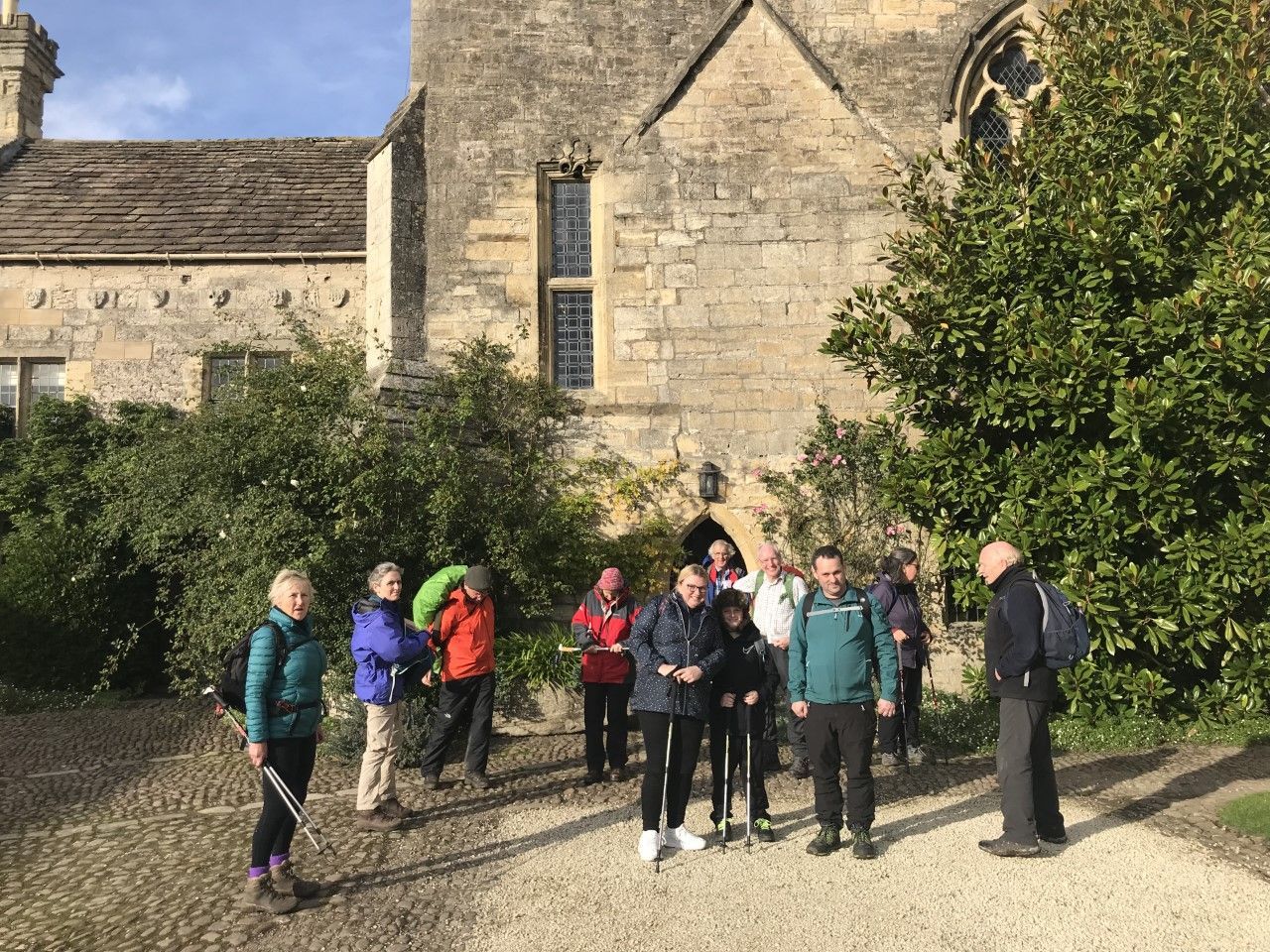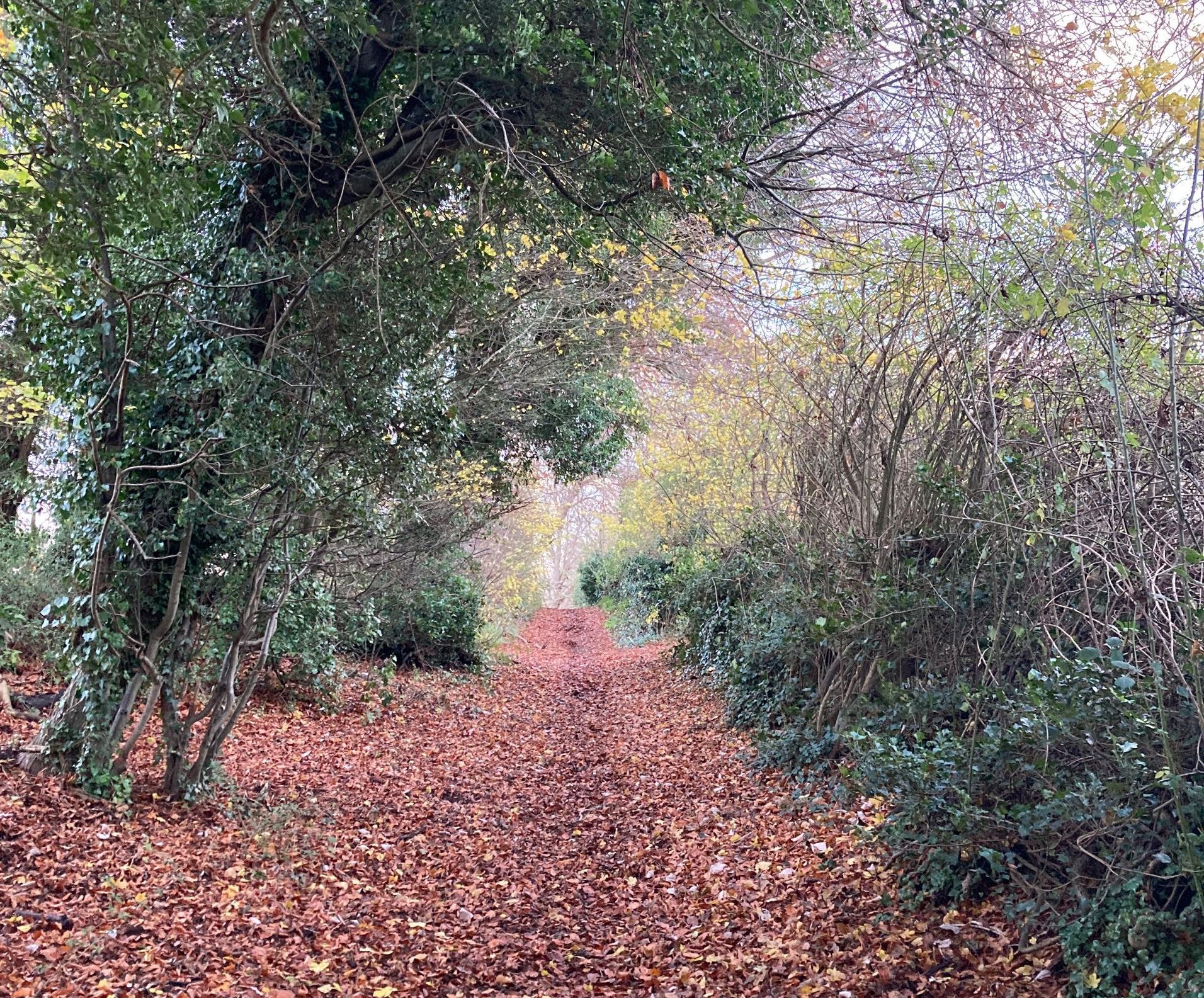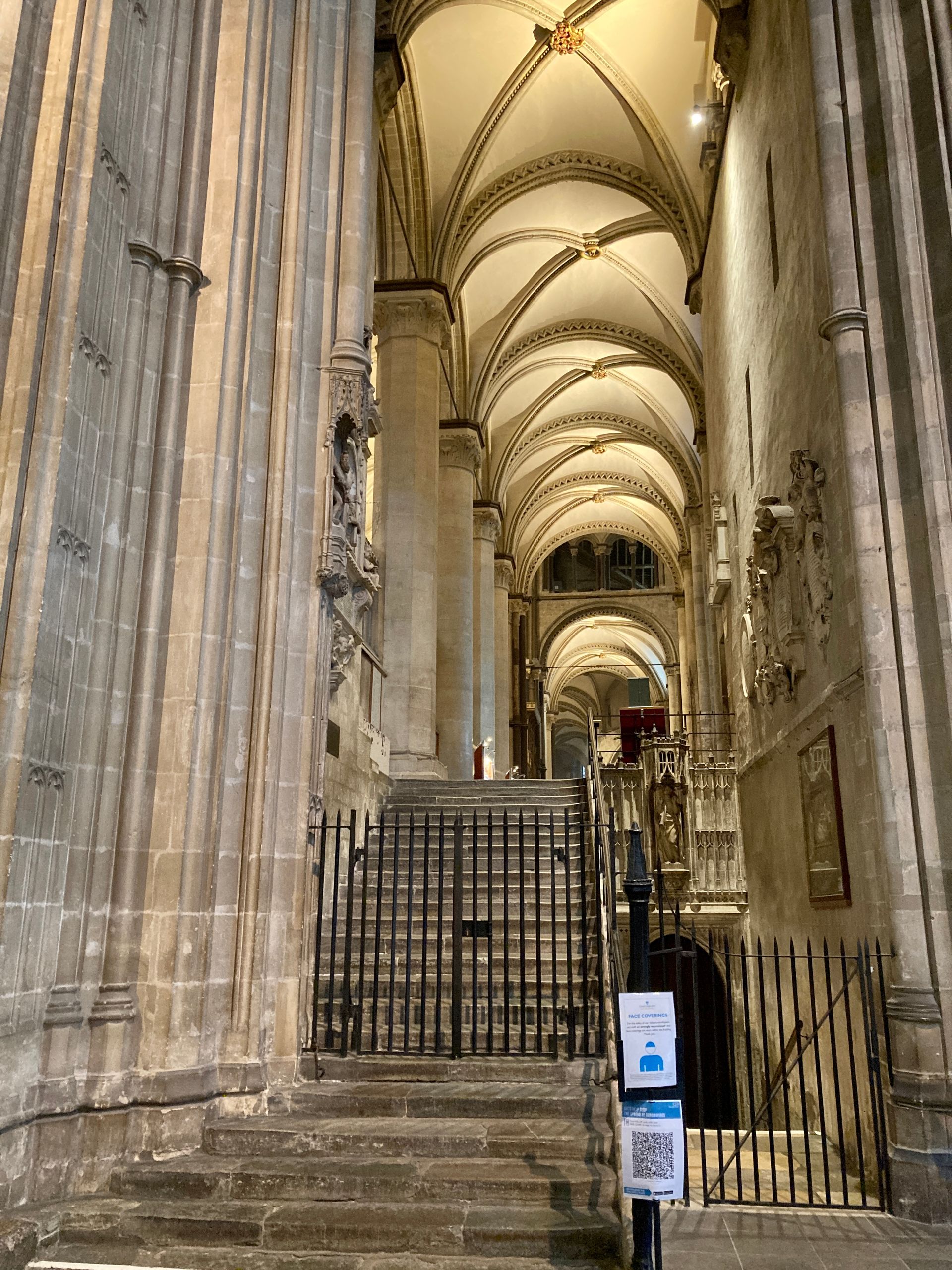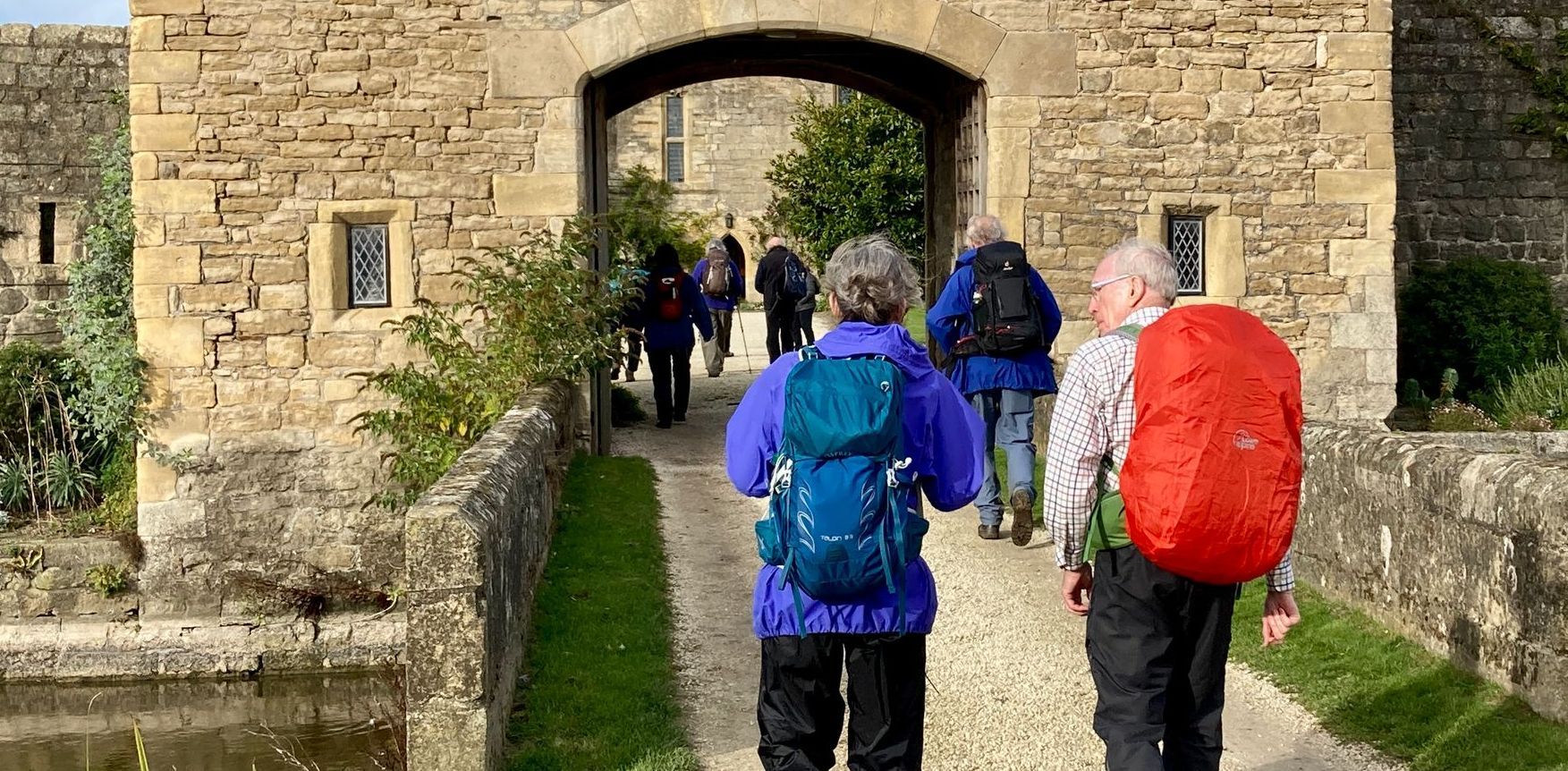The Augustine Camino
A Pilgrim Way in the Archdiocese of Southwark from the Shrine of Our Lady of Mount Carmel & St Simon Stock at Aylesford Priory to the Shrine of St Augustine at Ramsgate via the Shrine of St Jude at Faversham and the Becket Shrine and Martyrs Chapel at Canterbury
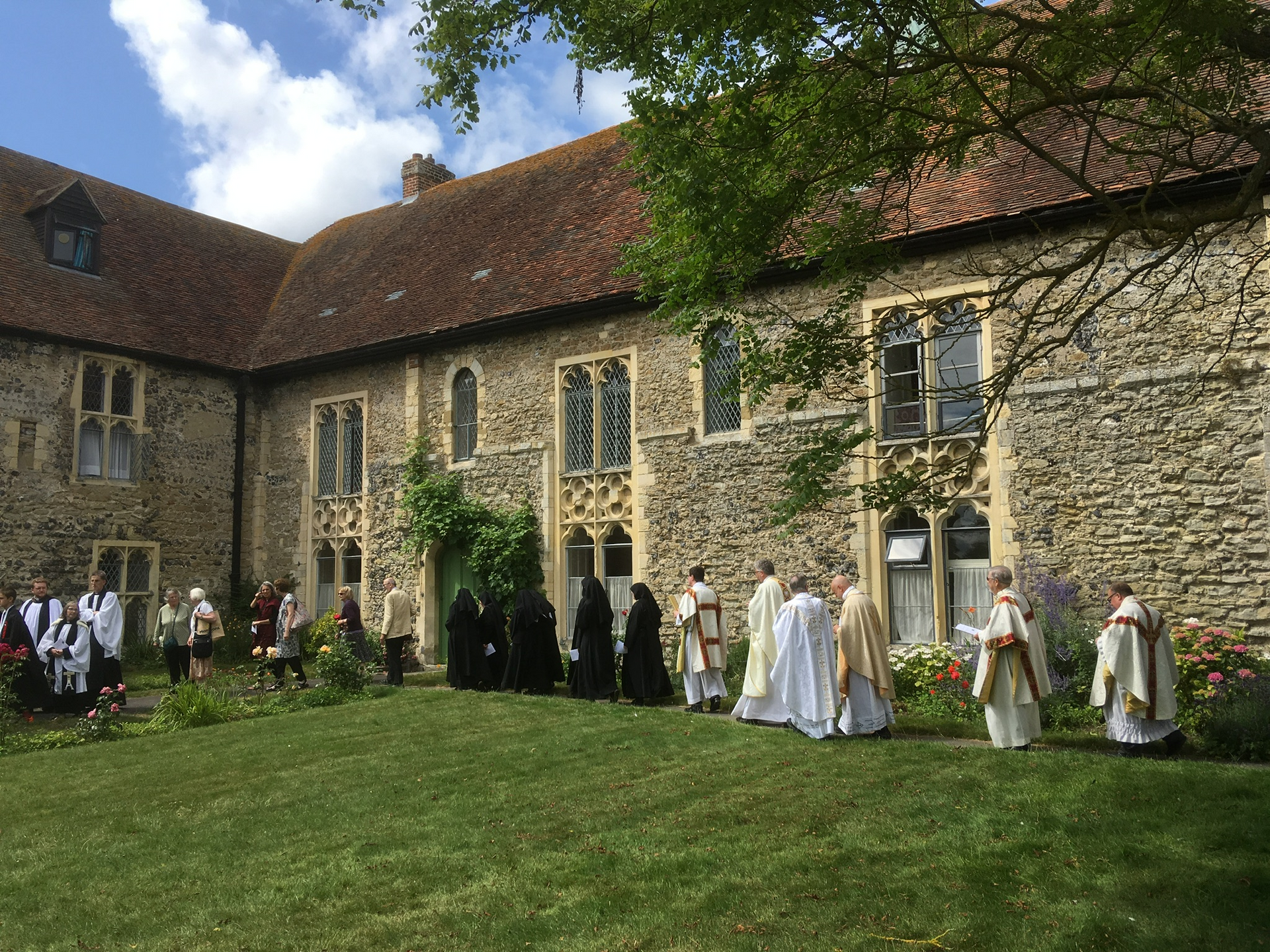
Annual St Mildred's Day Procession, Minster
(Photo Andrew Kelly)
About the route
St Augustine of Canterbury was a Roman monk who was sent by Pope Gregory the Great to evangelise the Anglo-Saxons. He became for the first archbishop of Canterbury in 597. He is considered the 'Apostle to the English'.
The Augustine Camino forms the third section of the Southwark Pilgrim Way from St George's Cathedral in Southwark, London to shrines at Aylesford, Faversham, Canterbury and Ramsgate. Please see the other Southwark pages for the first and second sections.
The route follows part of the Augustine Camino from Rochester to Ramsgate which was developed by Andrew Kelly. The route celebrates the mission of St Augustine to convert the English to Christianity, visiting many sites of global historical significance.
It also explores stunning examples of art and architecture, from the medieval to the modern, including work by the masters of the gothic revival, Pugin, Butterfield and Gilbert Scott. Beautiful villages and country pubs are conveniently placed all along the way. The Augustine Camino is an official feeder route for the Camino de Santiago. The Hearts in Search of God project is grateful to Andrew for his support and collaboration.
The Way follows a northerly route through countryside to reach the Shrine of St Jude at Faversham. From Faversham the path turns south east to cross the M2 and woodland to Canterbury Cathedral and the Becket Shrine and Martyrs Chapel in the Church of St Thomas, Canterbury. The Way continues east to the English Channel at Ramsgate and the Shrine of St Augustine and the National Pugin Centre.
You can find out more about the Way and download the GPX file by clicking on the LEARN MORE tab in the
interactive map below
Guidance
You can use the tabs in this section to find the information you need for your pilgrimage.
The Outer Way provides an overview of the route and links to the website of the Augustine Camino where you can buy the guidebook.
The Inner Way describes the spiritual highlights.
Use the button below to download the details of the inner and outer ways
Part of the Augustine Camino forms the third section of the Southwark Pilgrim Way from St George's Cathedral in Southwark, London to shrines at Aylesford, Faversham, Canterbury and Ramsgate. Please see the other Southwark pages for the first and third sections.
The Augustine Camino from Rochester to Ramsgate was developed by Andrew Kelly. The Camino celebrates the mission of St Augustine to convert the English to Christianity, visiting many sites of global historical significance. It also explores stunning examples of art and architecture, from the medieval to the modern, including work by the masters of the gothic revival, Pugin, Butterfield and Gilbert Scott. Beautiful villages and country pubs are conveniently placed all along the way. The Augustine Camino is an official feeder route for the Camino de Santiago. The Hearts in Search of God project is grateful to Andrew for his support and collaboration.
The Way follows a northerly route through countryside to reach the Shrine of St Jude at Faversham. From Faversham the path turns southeast to cross the M2 and woodland to Canterbury Cathedral and the Becket Shrine and Martyrs Chapel in the Church of St Thomas, Canterbury. The Way continues east to the English Channel at Ramsgate and the Shrine of St Augustine and the National Pugin Centre.
All the information needed for the pilgrimage can be found in Andrew Kelly’s excellent Guidebook to the Augustine Camino which covers the full route from Rochester to Ramsgate, including this section from Aylesbury to Ramsgate.
The Guidebook contains 48 pages of maps, directions, stories and photos, including a Pilgrim Passport. It is available for £7 plus P&P (UK and BFPO £2). (If purchasing from abroad please email admin@augustinecamino.co.uk to arrange payment. P&P rates (for one book) are as follows, Europe £5, USA £6, Rest of World £7)
The Guidebook is also available at Canterbury Cathedral shop, Rochester Cathedral, Aylesford Priory, St Jude’s Shrine Faversham and St Augustine’s Ramsgate.
In addition the Augustine Camino website provides a wealth of information about the Camino. Andrew Kelly also provides a booking service, guided walks and special events. For more information click on the link below.
Pilgrim people and places
The Carmelite Order arrived in Kent in 1242. They were forced from their priory at Aylesford during the Dissolution of the Monasteries in 1538, and the buildings were put to various uses over the centuries. In 1949 the Carmelites returned after an absence of over 400 years. They restored the tranquil gardens, built chapels and adorned them with fine ceramic artworks. Father Malachy Lynch who spearheaded the reconstruction, described the Friars as a “prayer in stone”.
The shrine at Aylesford is dedicated to Our Lady, and there are beautiful chapels dedicated to the saints of Carmel, notably St Simon Stock. Stock was an early Prior General of the Order who experienced a vision of Our Lady, perhaps at Aylesford. In the vison she gave him a scapula, two small pieces of brown cloth, joined together with cord, which is won over the shoulders. The scapular developed in the Renaissance as a miniature religious habit and became popular amongst lay people who want to have a discreet but visible sign of identifying with the Carmelite way of life. Stock died in 1261 and was buried in Bordeaux, but in 1951 some of his relics were brought to Aylesford and can be venerated in the Relic Chapel.
The National Shrine of Saint Jude
The National Shrine of Saint Jude, Apostle and Martyr, is based in Faversham and is primarily a place of prayer. Saint Jude is best known as the patron of desperate or difficult cases and so he is a saint of hope. In 1955, Fr Elias Lynch, a Carmelite friar, founded the Shrine for two reasons: first, because he was responding to the needs of the post-war generation who were looking for hope, and secondly because the Carmelite charism is so deeply rooted in the Word of God. Over the years it has been called “a jewel” and “a common meeting ground between Anglicans and Catholics”. In 2020, the Shrine was given five stars by the new guide 'Britain's Pilgrim Places' produced by the British Pilgrimage Trust.
Becket Shrine & Martyrs Chapel, Canterbury
The Catholic Church of St Thomas of Canterbury is within a 5-minute walk of Canterbury Cathedral. This charming gothic-style parish church is home to two relics of Becket; a finger bone and a piece of his vestment. The Martyrs Chapel houses a stole that once belonged to Saint Oscar Romero, and three major Reformation Martyrs, Saint John Fisher, Thomas More and John Stone, are also honoured. The church has several fine stained-glass windows, Stations of the Cross which were once in Westminster Cathedral and a striking Canterbury Saints Chapel. The church was designated as a Diocesan Shrine by Archbishop John Wilson in 2019.
The Church of St Dunstan, Canterbury
Whilst in Canterbury you may wish to visit the Church of St Dunstan where St Thomas More's head lies buried in the crypt of the Roper Chapel. More was Lord Chancellor of England during the reign of King Henry VIII. He refused to acknowledge the King as Supreme Head of the Church of England, and the annulment of his marriage to Catherine of Aragon. He was convicted of treason, beheaded and his head displayed on a pike on London Bridge. Margaret Roper, his beloved daughter, retrieved his head and brought it back to Canterbury for burial.
Canterbury Cathedral was founded in 597 and rebuilt between 1070 and 1077. The east end was enlarged at the beginning of the 12th century and largely rebuilt in the Gothic style following a fire in 1174, with extensions to accommodate the pilgrims visiting the shrine of St Thomas Becket, who was murdered in the Cathedral in 1170. The Norman nave and transepts survived until the late 14th century when they were demolished to make way for the present structures. Until the Reformation the cathedral was part of a Benedictine monastic community as well as being the seat of the archbishop.
The income from pilgrims to Becket's shrine largely paid for the rebuilding of the cathedral, but in 1538 Henry VIII summoned the long dead Becket to court to face charges of treason. Having failed to appear, Becket was found guilty in his absence and the treasures of his shrine confiscated and his tomb destroyed. It is still possible for pilgrims to visit the site of Becket’s murder. Today the Cathedral is an important tourist attraction with admission prices to match but pilgrims are admitted for free on presentation of the pilgrim passport.
Minster Abbey was founded by St Domneva in 670 AD on the site of the adjacent parish church. She was the great-granddaughter of King Ethelbert of Kent, the ruler who with his wife Bertha welcomed Saint Augustine on his mission to the Anglo-Saxons. In 741 the community had grown and relocated to the current site. The Monastery was sacked by the Vikings but was re-established during the Norman period. At the Dissolution of the Monasteries in 1538, Minster Abbey was taken by the Crown, and became a private dwelling for nearly 400 years. In 1937 the property came up for sale and a Benedictine community of women from Bavaria were able to found St Mildred’s Priory next to the ruins of the old Abbey. There is a guest house and tours can be arranged.
It is possible to join the Sisters for their services in the Abbey chapel. Relics of St Mildred, the second Abbess, are enshrined in the Chapel. Mildred led the monastic community with wisdom and love for more than 30 years. She was renowned as a peace maker and for being especially close to the poor.
Shrine of St Augustine & The National Pugin Centre, Ramsgate, Kent
The Church of St Augustine houses the Southwark diocesan shrine to the 'Apostle to the English'. St Augustine brought the Christian faith to England following the collapse of the Roman Empire. He arrived from Rome in 597 AD with forty monks at nearby Pegwell Bay. He had baptised King Ethelbert of Kent and ten thousand of his subjects within the year.
The Church holds authenticated relics of St Augustine, St Gregory the Great, who was the pope who oversaw the mission to the English, and St Lawrence, who became archbishop of Canterbury after Augustine. They are housed in a modern reliquary within the church which was built by the renowned 19th Century architect and Catholic convert, Augustus Pugin, who lived next door. The stories of Augustine and Augustus are told in the new Visitor Centre.
Prayer for Unity
O God,
Who by the preaching and miracles of blessed Augustine,
Your Confessor and Bishop,
who shed upon the people the light of the true faith;
grant that, through his intercession,
the hearts of those that have gone astray
may return to the unity of Your truth,
and that we may be of one mind in doing Your will.
Through our Lord Jesus Christ, Your Son,
Who lives and reigns with You in the unity of the Holy Spirit,
one world without end.
Amen.
ABOUT THE ARCHDIOCESE OF SOUTHWARK
In 1850, Pope Pius IX restored the Catholic hierarchy in England and Wales and created thirteen dioceses. As part of this restoration, the Diocese of Southwark was established covering much of southern England - London south of the Thames, Surrey, Kent, Sussex, Berkshire, southern Oxfordshire, Hampshire and the Channel Islands.
Two years before the restoration of the hierarchy St George’s Catholic Church, designed by Augustus Pugin, was opened and it was chosen as the Cathedral of the new Diocese. By the later 1800s, it had become clear that the Diocese of Southwark was too large and so in 1882, Pope Leo XIII created the Diocese of Portsmouth from the Diocese of Southwark. Hampshire, South Oxfordshire, Berkshire, and the Channel Islands became part of the new Diocese.
On the night of 16th April 1941, St George’s Cathedral was hit by an incendiary bomb which started a fire that destroyed the Cathedral but left other Diocesan buildings on the site undamaged. The Cathedral was rebuilt and consecrated in 1958.
On 28th May 1965, Pope Paul VI created a new Diocese of Arundel & Brighton from part of the Diocese of Southwark. East and West Sussex and Surrey (outside of the London boroughs) became part of this new Diocese. On the same date, the Diocese of Southwark was elevated to a Metropolitan See and its bishops became Archbishops.
